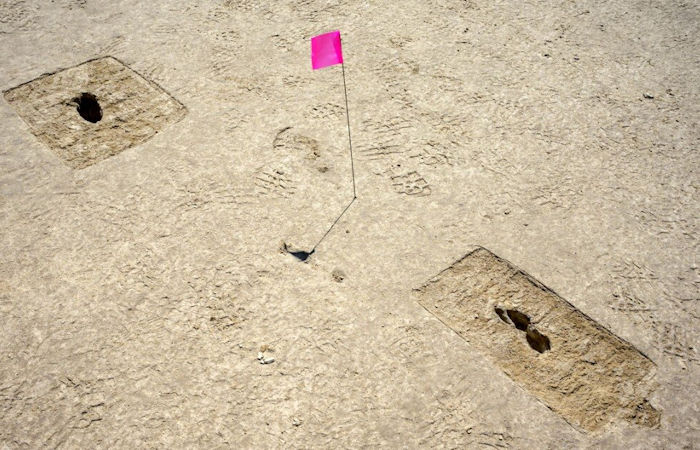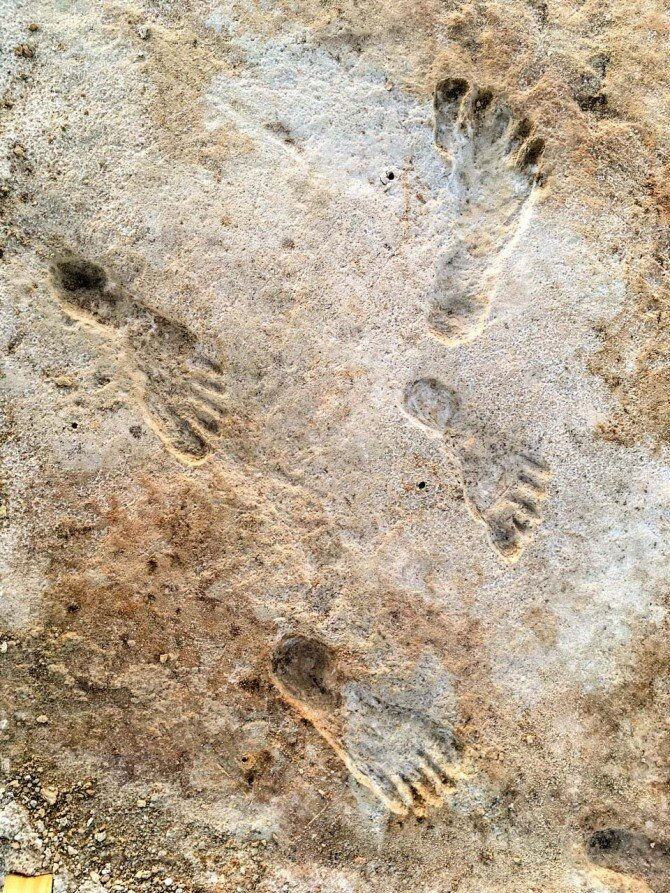Conny Waters – AncientPages.com – Human footprints believed to date from the end of the last Ice Age have been discovered on the salt flats of the Air Force’s Utah Testing and Training Range (UTTR) by Cornell researcher Thomas Urban in forthcoming research.
Urban and Daron Duke, of Far Western Anthropological Research Group, were driving to an archaeological hearth site at UTTR when Urban spotted what appeared to be “ghost tracks”—tracks that appear suddenly for a short time when moisture conditions are right and then disappear again.

Footprints discovered on an archaeological site are marked with a pin flag on the Utah Test and Training Range. Credit: R. Nial Bradshaw/Provided
Stopping to look, Urban immediately identified what to him was a familiar sight: unshod human footprints, similar to those he had investigated at White Sands National Park, including the earliest known human footprints in the Americas.
“It was a truly serendipitous find,” said Urban, a research scientist in the College of Arts and Sciences and with the Cornell Tree Ring Laboratory.
The researchers returned to the site the next day and began documenting the prints, with Urban conducting a ground-penetrating radar survey of one of the two visible trackways. Since he previously refined the application of geophysical methods, including radar, for imaging footprints at White Sands, Urban was able to quickly identify what was hidden.
“As was the case at White Sands, the visible ghost tracks were just part of the story,” Urban said. “We detected many more invisible prints by radar.”
Duke excavated a subset of the prints, confirming that they were barefoot and that there were additional unseen prints. Altogether, 88 footprints were documented, including both adults and children, offering insight into family life in the time of the Pleistocene.
“Based on excavations of several prints, we’ve found evidence of adults with children from about five to 12 years of age that were leaving bare footprints,” Duke said in an Air Force press release. “People appear to have been walking in shallow water, the sand rapidly infilling their print behind them—much as you might experience on a beach—but under the sand was a layer of mud that kept the print intact after infilling.”
Since there haven’t been any wetland conditions in at least 10,000 years that could have produced such footprint trails in this remote area of the Great Salt Lake desert, Duke said, the prints are likely more than 12,000 years old.

Footprints found at White Sands National Park in New Mexico, providing the earliest evidence of human activity in the Americas. Credit: Cornell University
Additional research is being done to confirm the discovery.
“We found so much more than we bargained for,” Anya Kitterman, the Air Force Cultural Resource Manager for the area, said in a statement.
Urban was working at the request of Duke, who had previously found two open-air hearths in the UTTR dated to the end of the Ice Age. At one of these hearth sites, Duke found the earliest evidence of human tobacco use. Those hearths were about a half-mile from the newly discovered footprints.
See also: More Archaeology News
The site has broader significance, according to Urban. “We have long wondered whether other sites like White Sands were out there, and whether ground-penetrating radar would be effective for imaging footprints at locations other than White Sands, since it was a very novel application of the technology,” he said. “The answer to both questions is ‘yes.'”
While the Utah site is not as old and may not be as extensive as White Sands, Urban said there may be much more to be found.
Written by Conny Waters – AncientPages.com Staff Writer





